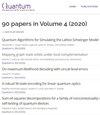Deep-Circuit QAOA
IF 5.1
2区 物理与天体物理
Q1 PHYSICS, MULTIDISCIPLINARY
引用次数: 0
摘要
尽管它很受欢迎,但一些实证和理论研究表明,量子近似优化算法(QAOA)在提供实质性的实际优势方面存在持续的问题。少量量子比特和浅层电路的数值结果充其量是模棱两可的,而经过充分研究的贫瘠高原现象为深层电路描绘了一幅相当发人深省的画面。然而,随着越来越多复杂的战略被提出以绕过贫瘠的高原,哪些问题实际上是根本的,哪些问题仅仅是——诚然是困难的——工程任务,这是理所当然的。通过将范围从通常考虑的参数景观转移到量子态空间的几何,我们可以区分那些根本难以解决的问题,独立于参数化,以及那些至少可以存在有利的参数化的问题。在这里,我们发现了一个明确的证据,即在没有进一步结构的一般优化任务上,QAOA存在“没有免费的午餐”行为;然而,个别情况需要更仔细地分析。基于我们的分析,我们提出并证明了一个可以通过单独评估经典目标函数的统计特性来访问的深电路QAOA性能指标。我们进一步讨论了一般QAOA实例在无限多门的渐近域所具有的各种有利性质,并详细说明了有限电路的内在缺陷。我们提供了基于局部搜索策略的深电路QAOA方法的几个数值示例,并发现-与我们的性能指标一致-一些特殊的函数类,如qubo,确实承认有利的优化前景。本文章由计算机程序翻译,如有差异,请以英文原文为准。
Deep-Circuit QAOA
Despite its popularity, several empirical and theoretical studies suggest that the quantum approximate optimization algorithm (QAOA) has persistent issues in providing a substantial practical advantage. Numerical results for few qubits and shallow circuits are, at best, ambiguous, and the well-studied barren plateau phenomenon draws a rather sobering picture for deeper circuits. However, as more and more sophisticated strategies are proposed to circumvent barren plateaus, it stands to reason which issues are actually fundamental and which merely constitute – admittedly difficult – engineering tasks. By shifting the scope from the usually considered parameter landscape to the quantum state space's geometry we can distinguish between problems that are fundamentally difficult to solve, independently of the parameterization, and those for which there could at least exist a favorable parameterization. Here, we find clear evidence for a 'no free lunch'-behavior of QAOA on a general optimization task with no further structure; individual cases have, however, to be analyzed more carefully.
Based on our analysis, we propose and justify a performance indicator for the deep-circuit QAOA that can be accessed by solely evaluating statistical properties of the classical objective function. We further discuss the various favorable properties a generic QAOA instance has in the asymptotic regime of infinitely many gates, and elaborate on the immanent drawbacks of finite circuits. We provide several numerical examples of a deep-circuit QAOA method based on local search strategies and find that – in alignment with our performance indicator – some special function classes, like QUBOs, indeed admit a favorable optimization landscape.
Based on our analysis, we propose and justify a performance indicator for the deep-circuit QAOA that can be accessed by solely evaluating statistical properties of the classical objective function. We further discuss the various favorable properties a generic QAOA instance has in the asymptotic regime of infinitely many gates, and elaborate on the immanent drawbacks of finite circuits. We provide several numerical examples of a deep-circuit QAOA method based on local search strategies and find that – in alignment with our performance indicator – some special function classes, like QUBOs, indeed admit a favorable optimization landscape.
求助全文
通过发布文献求助,成功后即可免费获取论文全文。
去求助
来源期刊

Quantum
Physics and Astronomy-Physics and Astronomy (miscellaneous)
CiteScore
9.20
自引率
10.90%
发文量
241
审稿时长
16 weeks
期刊介绍:
Quantum is an open-access peer-reviewed journal for quantum science and related fields. Quantum is non-profit and community-run: an effort by researchers and for researchers to make science more open and publishing more transparent and efficient.
 求助内容:
求助内容: 应助结果提醒方式:
应助结果提醒方式:


